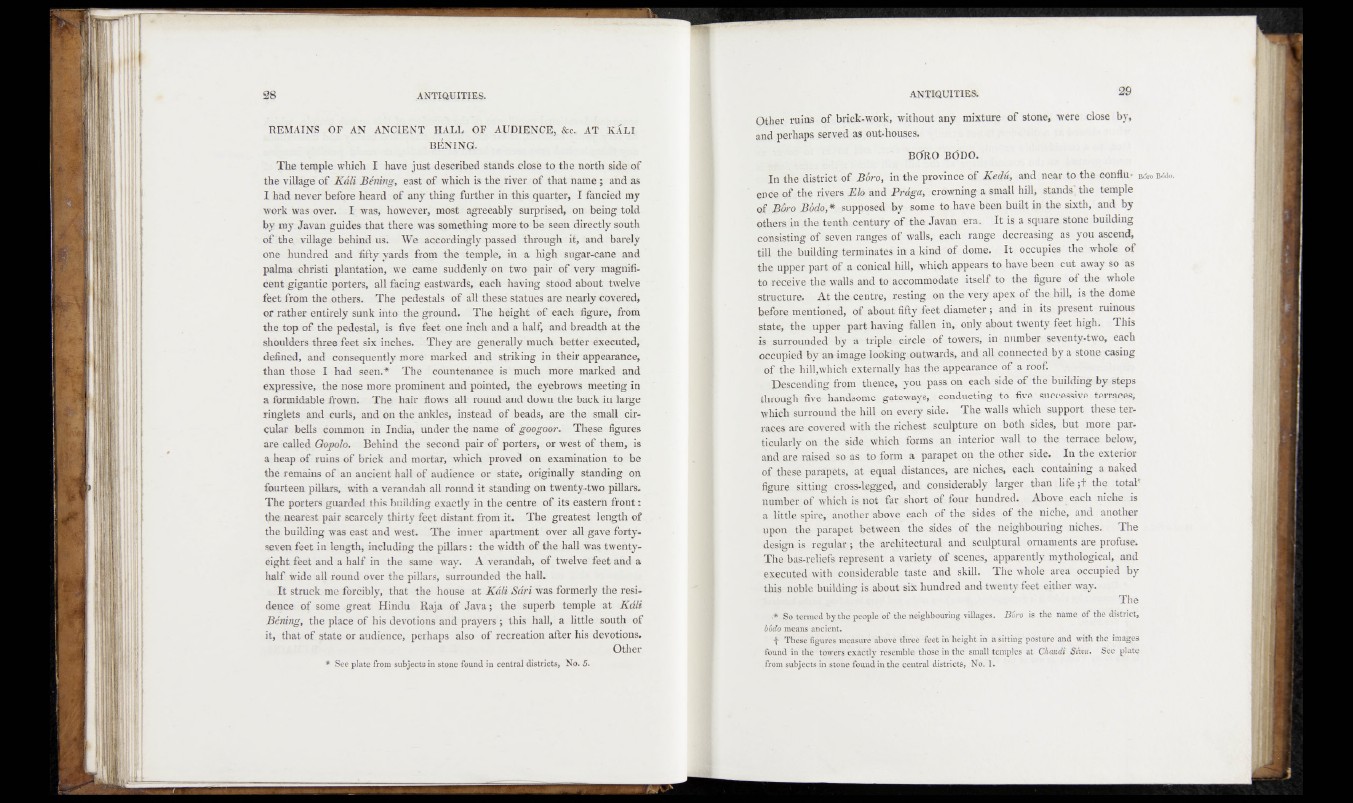
REMAINS OF AN ANCIENT HALE OF AUDIENCE, &c. AT KXH
B$NIN$.
The temple which 1 have just described stands close to the north side of
the village of Kali Bening, east of which is the river of that name; and as
I had never before heard of any thing further in this quarter, I fancied my
work was over. I was, however, most agreeably surprised, on being told
by my Javan guides that there was something more to be seen directly south
of the, village behind us. We accordingly passed through it, and hardly
one hundred and fifty yards from the temple, in a high sugar-cane and
palma christi plantation, we came suddenly on two pair of very magnificent
gigantic porters, all feeing eastwards, each having stood about twelve
feet from the others. The pedestals of all these statues are nearly covered,
at rather entirely sunk into the ground. The height of each figure, from
the top of the pedestal, is five feet one inch and a half, and breadth at the
shoulders three feet six inches. They are generally much better executed,
defined, and consequently more marked and striking in their appearanee,
than those I had seen.* The countenance is much more marked and
expressive, the nose more prominent and pointed, the eyebrows meeting in
a formidable frown. The hair flows all round and down the back in large
ringlets and curls, and cm the ankles, instead of beads, are the small circular
bells common in India, under the name of go&gaor. These figures
are called Gopolo. Behind the second pair of porters, or west qf them, is
a heap of ruins of brick and mortar, which proved on examination to be
the remains of an ancient hall of audience or state, originally standing on
fourteen pillars, with a verandah all round it standing on twenty-two pillars.
The porters guarded this building exactly in the centre of its eastern front:
the, nearest pair scarcely thirty feet distant from it. The greatest length of
the building was east and west. The inner apartment over all gave forty-
seven feet in length, including the pillars: the width of the hall was twenty-
eight feet and a half in the same way. A verandah, of twelve feet and a
half wide all round over the pillars, surrounded the hall.
It struck me forcibly, that the house at Kali Sari was formerly the residence
of some great Hindu Raja of Java; the superb temple at Kdli
Bening, the place of his devotions and prayers; this hall, a little south of
it, that of state or audience, perhaps also of recreation after his devotions.
Other
Otbec ruins of brick-work, without any mixture of stone, were close by,
and perhaps served as outhouses.
BÖÏIO BÓDO.
In the district öf Bóro, in the province of Kedu, and near to the confln- ba» bmo.
enee of the rivers Kk> and Braga, crowning a small hill, stands, the temple
of Bóro Bódo,* supposed by some to have been built in the sixth, and by
Others in the tenth century of the Javan era. It ia a square stone building
consisting of seven ranges of walls, each range decreasing as you ascend,
till the builefing terminates in a kind of dome. It occupies the whole of
the upper part of a conical hill, which appears to have been cut away so as
to receive the walls and to accommodate itself to the figure of the whole
structure. A t the centre, resting on the very apex of fee MU, is the dome
before mentioned, of about fifty feet diameter; and in its present ruinous
state, the upper part having fallen in, only about twenty feet high. This
is surrounded by a triple circle of towers, in number seventy-two* each
occupied by anfrnage looking ontwarde and aft connected by a stone casing
of the hill,which externally has thé appearance of a roof.
Descending from thence, you pass on each side of the building by steps
through five handsome gateways, conducting to five successive terra««,
which surround the hill on every side. The walls which support these terraces
are covered with the richest sculpture on both sides, but more particularly
on thé side which forms ap interior wall to the terrace below,
and are raised so as to form a parapet op the other side. In the exterior
of these parapets, at equal distances, are niches, each containing a naked
figure sitting cross-legged, and considerably larger than life;t fee total*
number of which is not far short of four hundred. Above each niche is
a little spire, another above each of the sides of fee niche, and another
upon the parapet between the sides of fee neighbouring niches. The
design is regular; the architectural and sculptural ornaments are profuse.
The bas-reliefs represent a variety of scenes, apparently mythological, and
executed with considerable taste and skill. The whole area occupied by
this noble building is about six hundred and twenty feet either way.
The
.* So termed by the people of the neighbouring villages. Boro is the name of the district,
bódo means ancient.
f These figures measure above three feet in height in a sitting posture and with the images
found in the towers exactly resemble those in the small temples at Chandi SAvu. See plate
from subjects in stone found in the central districts, 'No. 1.